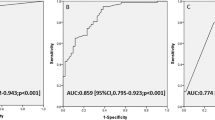Abstract
Purpose
Hyperglycemia is a common secondary insult associated with an increased risk of mortality and poor outcome in traumatic brain injury (TBI), but the effect of hyperglycemia on outcomes of severe TBI in children and adolescents is less apparent. The aim of this study was to evaluate the association of hyperglycemia with mortality in pediatric patients with severe TBI.
Methods
In this cross-sectional study, data of all children and adolescents with severe TBI admitted to Poursina Hospital in Rasht, including age, gender, Glasgow Coma Scale (GCS) upon admission, mortality rate, hospital length of stay, and serial blood glucose during the first three consecutive ICU days following admission, were reviewed from April 2007 to May 2011. After univariate analysis and adjustment for related covariates, logistic regression model was established to determine the association between persistent hyperglycemia and outcome.
Results
One-hundred and twenty-two children were included with a median admission GCS of 6 (interquartile range (IQR) 5–7) and a median age of 13 years (IQR 7.75–17). Among them, 91 were boys (74.6 %) and 31 were girls (26.6 %); the overall mortality was 40.2 % (n = 49). Patients who died had a significantly greater blood glucose levels than survivors for the first 3 days of admission (P = 0.003, P < 0.001, P = 0.001, respectively). Moreover, persistent hyperglycemia during the first 3 days of admission had an adjusted odds ratio of 11.11 for mortality (P < 0.001).
Conclusion
Early hyperglycemia is associated with poor outcome, and persistent hyperglycemia is a powerful and independent predictor of mortality in children and adolescents with severe TBI.

Similar content being viewed by others
References
Krug EG, Sharma GK, Lozano R (2000) The global burden of injuries. Am J Public Health 90(4):523–526
Langlois JA, Rutland-Brown W, Thomas K (2006) Traumatic brain injury in the United States: emergency department visits, hospitalizations, and deaths. Centers for Disease Control and Prevention, National Center for Injury Prevention and Control, Atlanta
Carrick M, Tyroch A, Youens CA, Handley T (2005) Subsequent development of thrombocytopenia and coagulopathy in moderate and severe head injury: support for serial laboratory examination. J Trauma 58(4):725–730
Cochran A, Scaife ER, Hansen KW, Downey EC (2003) Hyperglycemia and outcomes from pediatric traumatic brain injury. J Trauma 55:1035–1038
Kreutziger J, Schlaepfer J, Wenzel V, Constantinescu M (2009) The role of admission blood glucose in outcome prediction of surviving patients with multiple injuries. J Trauma 67(4):704–708
Jeremitsky E, Omert L, Dunham CM, Wilberger J, Rodriguez A, General A (2005) The impact of hyperglycemia on patients with severe brain injury. J Trauma 58(1):47–50
Salim A, Hadjizacharia P, DuBose J, Brown C, Inaba K, Chan LS, Margulies D (2009) Persistent hyperglycemia in severe traumatic brain injury: an independent predictor of outcome. Am surge 75(1):25–29
Parish RA, Webb K (1988) Hyperglycemia is not a poor prognostic sign in head-injured children. J Trauma 28:517–519
Melo JRT, Reis RC, Lemos-Júnior LP, Coelho HMS, Almeida CERd, Oliveira-Filho J (2009) Hyperglycemia in pediatric head trauma patients: a cross-sectional study. Arq Neuropsiquiatr 67:804–806
Melo JR, Di Rocco F, Blanot S, Laurent-Vannier A, Reis R, Baugnon T, Sainte-Rose C, Olveira-Filho J, Zerah M, Meyer P (2010) Acute hyperglycemia is a reliable outcome predictor in children with severe traumatic brain injury. Acta Neurochir (Wien) 152(9):1559–1565
Kan CH, Saffari M, Khoo TH (2009) Prognostic factors of severe traumatic brain injury outcome in children aged 2–16 years at a major neurosurgical referral centre. Malaysian J Med Sci 16(4):25–33
Griesdale DEG, Tremblay M-H, McEwen J, Chittock DR (2009) Glucose control and mortality in patients with severe traumatic brain injury. Neurocrit Care 11:311–316
Aşılıoğlu N, Turna F, Ms P (2011) Admission hyperglycemia is a reliable outcome predictor in children with severe traumatic brain injury. J Pediatr (Rio J) 87(4):325–328
Marton E, Mazzucco M, Nascimben E, Martinuzzi A, Longatti P (2007) Severe head injury in early infancy: analysis of causes and possible predictive factors for outcome. Childs Nerv Syst 23:873–880
Acknowledgments
The authors appreciate the insightful cooperations of Guilan Trauma Research Center and Poursina Hospital staffs. The authors thank the patients and families who participated in this study.
Conflict of interest
The authors declare that there is no conflict of interest.
Author information
Authors and Affiliations
Corresponding author
Rights and permissions
About this article
Cite this article
Seyed Saadat, S.M., Bidabadi, E., Seyed Saadat, S.N. et al. Association of persistent hyperglycemia with outcome of severe traumatic brain injury in pediatric population. Childs Nerv Syst 28, 1773–1777 (2012). https://doi.org/10.1007/s00381-012-1753-5
Received:
Accepted:
Published:
Issue Date:
DOI: https://doi.org/10.1007/s00381-012-1753-5




